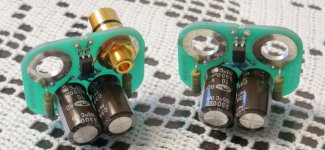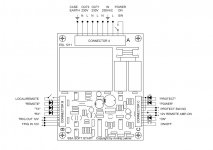I have for sale special amplifier control board, designed by our forum member LazyCat. This board provide everything a amplifier should have for normal operation & protection:
-push button activation
-soft start (via thermistor and bypassed with special high inrush Schrack relay after few seconds)
-DC detection (control board consists also two small pcb boards that are mounted on amplifier speaker terminal, providing DC sensing via optocoupler (galvanic separation)
-TX & RX
-12V trigger out/in
-LED indication on/off/fault/delay
This is state of the art control board, probably unique on diy market.
Price for amplifier boards + 2 DC detection boards : 65 EUR + post cost
contact: moonaudio (at) gmail.com
-push button activation
-soft start (via thermistor and bypassed with special high inrush Schrack relay after few seconds)
-DC detection (control board consists also two small pcb boards that are mounted on amplifier speaker terminal, providing DC sensing via optocoupler (galvanic separation)
-TX & RX
-12V trigger out/in
-LED indication on/off/fault/delay
This is state of the art control board, probably unique on diy market.
Price for amplifier boards + 2 DC detection boards : 65 EUR + post cost
contact: moonaudio (at) gmail.com
Attachments
Has this design been discussed anywhere?
It looks very interesting...
The designer is LazyCat (nickname on this forum). He is the author of SSA and VSSA threads in solid state section.
The circuit works in the way that when push button switch is actuated, the first Schrack relay turn on, after few seconds another Schrack relay bypass thermistor. If there is any DC detected on speaker terminals (+-1V or greater) the control circuit switch off amplifier mains off. Also speaker detection is galvanic separated from control circuit by optocoupler. So there is no relay in speaker path, also there is no danger that speaker relay would fail in case of several tenth of DC voltage.
I think this is best protection ever available for protection amplifiers. I am selling it, cause will use some SMPS on future project. 😎
Yes, I am aware of the nice designs LazyCat has shared over the years, but I have not seen this one before, hence my query.
This is indeed a realy nice design and layout, just like all the other stuff I have seen from LazyCat.
This is indeed a realy nice design and layout, just like all the other stuff I have seen from LazyCat.
I can offer also high quality 19 mm vandal resistant green illuminated push button switch:
http://www.diyaudio.com/forums/swap-meet/233997-fs-bulgin-19-mm-push-button-green-ilumination.html
http://www.diyaudio.com/forums/swap-meet/233997-fs-bulgin-19-mm-push-button-green-ilumination.html
this is not a good protection for big Class A amps. or any amps with a big PSU and that do not cut off speaker output on turn off.
my amp stay on and playing for several sec after turn off. and if i then have gotten full rail DC on the speaker. the DC detection would not do anything to save the speakers.
my amp stay on and playing for several sec after turn off. and if i then have gotten full rail DC on the speaker. the DC detection would not do anything to save the speakers.
this is not a good protection for big Class A amps. or any amps with a big PSU and that do not cut off speaker output on turn off.
my amp stay on and playing for several sec after turn off. and if i then have gotten full rail DC on the speaker. the DC detection would not do anything to save the speakers.
Well...the truth is, that the relay, which would not deteriorate signal and provide 100% DC protection, do not exist. The main problem of relay is, that most of them cannot switch off DC voltages greater than 30V DC, also the material from contacts are made, can also have some effect on sound. There are some compromises around like Amplimo relay for example, but question is, how these contact will deteriorate during time. Anyway...dc on loudspeaker terminals means amplifier fatal error, so it advisable to switch off mains power asap too.
It is true, that with this protection some energy would be stored in capacitor bank, but since mid range and tweeter driver already are protected with series capacitor, bass driver should remain unaffected. However, if someone is still concerned, simple relay can be added in series with loudspeaker terminal. Coil from this relay should be wired parallel to main relay. If DC get detected, mains voltage will get down immediately, together with speakers.😎
Anyway...dc on loudspeaker terminals means amplifier fatal error, so it advisable to switch off mains power asap too.
one bad solder joint, screw connection or for another reason loss of half the PSU and you have full rail DC on the speakers.
- Status
- Not open for further replies.


